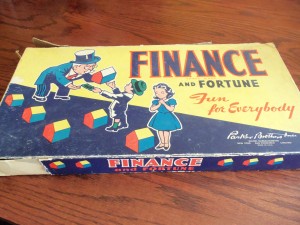There have been some incredible innovations in journalism over the past few years, particularly around fast-paced, microchunked news creation and distribution. Some might even argue the native format for news in a networked world has been discovered in the form of the Live Blog.
However, increasing the speed and reducing the size of the information bits that hit us does not inherently make us smarter.
The big, heavy, complicated issues that shape our world and our place in it can surely be discussed in native formats for the networked world, too.
What’s the best way to make stories with longer arcs that run parallel to the fast-paced news agenda more accessible to people? Issues like education reform, globalisation, ethics in biotechnology, energy security, poverty, pandemics, etc.
 In the coming weeks and months we’re going to see journalist/anthropologist Joris Luyendijk openly exploring the world of finance via the Guardian. He’ll publish interviews and insights online and in print in an attempt to make this otherwise opaque industry more accessible and maybe even entertaining to everyone who is not inside the finance industry.
In the coming weeks and months we’re going to see journalist/anthropologist Joris Luyendijk openly exploring the world of finance via the Guardian. He’ll publish interviews and insights online and in print in an attempt to make this otherwise opaque industry more accessible and maybe even entertaining to everyone who is not inside the finance industry.
The tools at his disposal initially will include the many reporting capabilities available via the Guardian digital platform. The output will initially be text, data and multimedia, but he’s also interested in seeing how we could use all of his work to serve people in an ongoing way.
In the past people have turned long form journalism into books for posterity. But maybe there’s another way.
I’m guessing most people would answer ‘Wikipedia’ if asked where to find an accessible view into a complex issue. That would be an excellent answer. Most big topic pages in Wikipedia include a lot of depth including historical background, philosophical positions and good footnotes.
But the Wikipedia page is at best just one entry point on the journey toward understanding more complicated issues.
Many others now including innovative media organisations are exploring new approaches to breaking open long topics for the rest of us and showing some real success with it.
 ProPublica’s analysis of educational accessibility in the United States, The Opportunity Gap, is a wonderful approach to bridging the gap between huge volumes of data and real human issues in the education system. The Economist hosts interactive debates with experts, and the New York Times is making some wonderful interactive news projects come to life. The new poll format employed after Osama bin Laden’s death to help people identify what that event meant to them was brilliant.
ProPublica’s analysis of educational accessibility in the United States, The Opportunity Gap, is a wonderful approach to bridging the gap between huge volumes of data and real human issues in the education system. The Economist hosts interactive debates with experts, and the New York Times is making some wonderful interactive news projects come to life. The new poll format employed after Osama bin Laden’s death to help people identify what that event meant to them was brilliant.
What these examples point to is a format that fuels better conversation rather than better packaging.
I think we can go much further still.
Dutch philosopher Johan Huizinga argued in the 1930’s that play is more important to culture than we typically recognize. He was famous for saying, “Let my playing be my learning, and my learning be my playing.â€
Justice Sandra Day O’Connor founded a program called iCivics after she retired in 2006 designed to raise understanding and engagement in democracy. The organisation partnered with a game developer Filament Games to create several web-based games and teaching materials.
While some may argue that edutainment fails on both accounts – you don’t learn, and you don’t have fun – the ability to communicate complex issues through some form of play can be very powerful.
There are many applicable lessons about how the world really works to be learned from spending time with the Sims, Civilization, World of Warcraft and newer games like Eve online.
 The world’s most successful board game ever made was an attempt to explain the economic theories of Henry George – Monopoly. In fact, an early variant of the game was actually called “The Fascinating Game of Finance.â€
The world’s most successful board game ever made was an attempt to explain the economic theories of Henry George – Monopoly. In fact, an early variant of the game was actually called “The Fascinating Game of Finance.â€
After listening to Joris and what he’s trying to do it’s easy to see that the player roles, game mechanics and environments for an imaginative new game are right at his fingertips. He will be talking to asset managers, brokers, lobbyists, analysts, CEOs, investors, academics and many others. They will tell him how the real game of finance works today.
 Now, we don’t know how to make a good game, and we don’t even have a conception of whether we should try to create a single game or a collection of games. For example, might it make some sense to develop simple card games like Crunch – “the game for utter bankersâ€?
Now, we don’t know how to make a good game, and we don’t even have a conception of whether we should try to create a single game or a collection of games. For example, might it make some sense to develop simple card games like Crunch – “the game for utter bankersâ€?
How do you keep score? What kinds of achievements will work? What’s the relationship with real world data? How does distribution work?
Also, what kinds of costs are we talking about? There are some fascinating approaches to funding and licensing games via Kickstarter, such as the NASA-backed multi-player online game. Should we use a similar model?
The first step is to initiate the discussion, set the stage for the right things to happen.
Joris will lead the way on his blog and start explaining what the real game of finance looks like and how it works.
Our hope is that we can create the environment for a real game to develop backed off what Joris finds in his research.
If you’re interested in coming along on this journey with us, please follow Joris on twitter @JLbankingblog and check in on his banking blog on the Guardian.